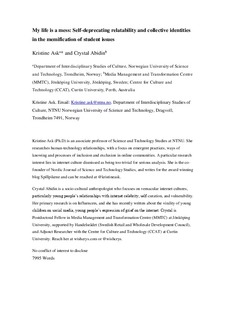| dc.contributor.author | Ask, Kristine | |
| dc.contributor.author | Abidin, Crystal | |
| dc.date.accessioned | 2019-03-28T13:33:20Z | |
| dc.date.available | 2019-03-28T13:33:20Z | |
| dc.date.created | 2018-08-31T11:52:41Z | |
| dc.date.issued | 2018 | |
| dc.identifier.citation | Information, Communication & Society. 2018, 21 (6), 834-850. | nb_NO |
| dc.identifier.issn | 1369-118X | |
| dc.identifier.uri | http://hdl.handle.net/11250/2592260 | |
| dc.description.abstract | In this paper, we investigate memes about student issues. We consider the memes as expressions of a new networked student public that contain discourses that may fall outside the mainstream discourse on higher education. The paper is based on content analysis of 179 posts in the public Facebook Group ‘Student Problem Memes’, combined with a nine-month media watch and a discussion workshop with 15 students. Through self-deprecating humour, students create an inverse attention economy of competitive one-downmanship, where the goal is to display humorous failure instead of perfect appearance. Our analysis shows that students use humour to express, share, and commiserate over daily struggles, but also that the problems related to work/study balance and mental health, are experienced as a persistent feature of student living. We also analyse limitations of meme-based publics, emphasizing processes of inclusion and exclusion through specific vernaculars of visual and discursive humour where issues related to gender, race, orientation, class, and ability are sidelined in favour of relatable humour. | nb_NO |
| dc.language.iso | eng | nb_NO |
| dc.publisher | Taylor & Francis | nb_NO |
| dc.title | My life is a mess: self-deprecating relatability and collective identities in the memification of student issues | nb_NO |
| dc.type | Journal article | nb_NO |
| dc.type | Peer reviewed | nb_NO |
| dc.description.version | acceptedVersion | nb_NO |
| dc.source.pagenumber | 834-850 | nb_NO |
| dc.source.volume | 21 | nb_NO |
| dc.source.journal | Information, Communication & Society | nb_NO |
| dc.source.issue | 6 | nb_NO |
| dc.identifier.doi | 10.1080/1369118X.2018.1437204 | |
| dc.identifier.cristin | 1605787 | |
| dc.description.localcode | Locked until 19 August 2019 due to copyright restrictions. This is an Accepted Manuscript of an article published by Taylor & Francis in Information, Communication & Society on 19 February 2018, available at https://doi.org/10.1080/1369118X.2018.1437204 | nb_NO |
| cristin.unitcode | 194,62,40,0 | |
| cristin.unitname | Institutt for tverrfaglige kulturstudier | |
| cristin.ispublished | true | |
| cristin.fulltext | postprint | |
| cristin.qualitycode | 1 | |
